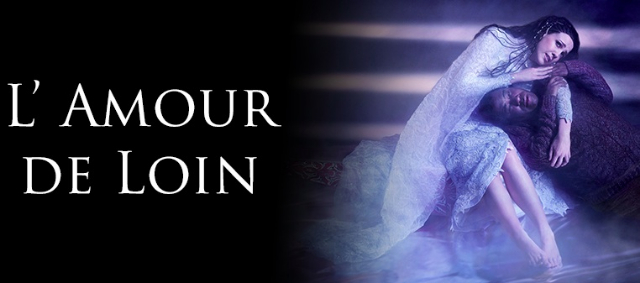Love at a Distance by Kaija Saariaho
Heralded Across the Continent, So So at the Met Opera
By: Susan Hall - Dec 22, 2016
The music comes out of Paris and Boulez and yet is very much her own in L’Amour de Loin by Kaija Saariaho. It has arrived at the Metropolitan Opera having gotten rave reviews since it was first put on in Salzburg in 2000.
Robert Lepage has picked up the central texture of the music and story in presenting a beautiful and evocative picture of the sea across the Metropolitan Opera’s giant stage. Bars sparkle in different colors. The dancing colors look like they are stimulated by sound, but the Metropolitan Opera press office reports that they are not. They do seem to suit the orchestral score perfectly. Both are beds, one of sound and the other of light. Both feel like water. The chorus often appears as heads bobbing on the water's surface.
Saariaho's music is called spectral, which means that it is developed, in this case in part by electronic or other artificial means, to create a timbre. The Met orchestra performed this music beautifully under Susanna Mälkki. She is only the fourth female conductor to lead a Met Opera performance. It is because Mälkki is a wonderful conductor that we should take note. Her arms move in an open embrace of the music. She holds together the deep bass parts of the drums, strings and brass and the top flutes and piccolos.
In between are the human voices. Saariaho's lines are made to sit comfortably in the singer’s voices. She is a gifted composer of opera.
While the orchestral score stays in the same realm of harmonics and textures, and there is no perceivable arc. The story definitely has an arc but it is not apparent at the Met.
Susanna Phillips (Countess) has a lovely voice, but she is permitted to give a ho-hum performance, seeming to shrug her shoulders and say, So What.
Eric Owens is a great singer, but simply not suited to this role. While the costume designer has helped cover his girth with an elegant jacket, when he exits the stage on his back he looks like a beached whale. He is supposed to be playing a prince troubadour. Gerald Finley and Russell Braun, masters of song, have filled the role in the past. Thomas Hampson also comes to mind for the role.
Tamara Mumford performs credibly as the Pilgrim, the architect of a meeting between the Troubadour and his imagine adored, a Tunisian Countess. The pilgrim gets the graphically most pleasing boat to steer, a long, thin, canoe-like object which she poles from Europe to North Africa. The only feature of the Lepage stage that is awkward is a set of stairs which may have been purchased from an airline. They perform multiple functions, but are ugly, except when the Countess, standing on her ‘balcony,' recedes into the back of the stage at the end of the opera.
This original and provocative opera got good production and a wonderful orchestral performance, but missing the opportunity to show the story’s arc made it seem flat. That is unfair to both audience and performers alike.

